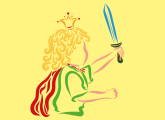Alison Davies explains why terrible tales of wicked witches, creepy crawlies and monsters at the end of the bed can be a vital part of young children’s emotional development…
There’s nothing like a scary story to capture the imagination and keep an audience engrossed. Whatever our age, we can’t help but get carried away with the atmosphere and the inevitable twists and turns. We re-create each scene in our mind and identify with the characters’ emotions. It’s easy to build a picture of the monster at the end of the bed, or the ghostly apparition in the graveyard because these are common fears that linger in our subconscious from an early age. But are these tales appropriate for little ones, and if so, when should we start to use them?
You may instinctively shy away from using spooky stories with under-fives, but in fact these tales are essential for early development. Because the characters are put in scary situations there’s a roller coaster of emotions to deal with. These stories allow you to illustrate light and dark with your voice and facial expression, so that very young children begin to understand different emotions. They get carried along by the tone of your voice, and soon realise when something exciting is about to happen.
You might wonder if this type of story could cause alarm, but it’s all about giving the content a sense of fun as well as making it spooky enough to hold wandering attentions.
As children grow they begin to understand that there will be times when they’ll feel challenged or scared. Tales like this allow them to feel fear in a safe environment. There’s the opportunity to experience the thrill of the adventure without the imminent threat of danger. They know it’s not real, and that they can close the book at any point, but to experience the excitement they must engage their imagination and lose themselves in the story. It’s no wonder that horror remains such a popular genre in films and books.
There are some great picture books available with lovely spooky tales that young children will enjoy. But why not have a go at creating something new to suit your needs? The key is simplicity. Think of the story in terms of three boxes: beginning, middle and end. Then think about how you’re going to connect them together with a narrative thread. Stick with a straightforward plot that you can adapt, for example…
● A child stumbles on a magic stone/box/wand/umbrella that takes him or her to a world inhabited by friendly monsters/ghosts/dinosaurs, etc.;
● A child discovers a creepy house on a hill, and decides to explore. Who lives in the creepy house and what sort of noises do they make? This leaves lots of scope for interaction as you can include monsters, witches, werewolves, cats, flapping bats, scuttling spiders, ghosts and ghouls.
● A witch needs help with a spell to make all the little children of the world sleep peacefully. What does she put in her cauldron – sweets, chocolate, cake, jelly, ice cream? How many times does she stir it and in which direction?
In a spooky story you need a mix of characters who the children can identify with, and some creepy creatures to create a scary atmosphere. It’s important that the main protagonist is the same sort of age as they are, and shares similar experiences with the group. Think about the types of things that they would do every day, for example, playing in the park or even going to nursery, and use these experiences as the basis for your story.
Next, think about the scary element. An effective way to introduce this is to use an archetype that represents something spooky, like a creepy old house, or a character like a witch, monster or ghost. The children will immediately draw on other story experiences to create a picture of this in their minds, but you can help them along by asking questions.
● Ask the children to show you how a character would move. What sort of noises would it make? Whenever it appears in the story, encourage them to join in with the sounds and movements and pretend they’re the monster/witch/ghost.
● Make the character stand out and add a touch of humour by giving it something silly to wear. So it could be a monster wearing Wellington boots, or a ghost with a big straw hat.
● Introduce a rhyming element to your tale. Go for something simple like, “The ghost went wooooooo, the clock struck two, and the monster growled, ‘Where’s my elephant stew?’”
● Then create simple actions that the children can join in with. At intervals in the story ask the question “What happened next?” then chant the rhyme. This gives you the opportunity to repeat it as often as you like, making the tale fun and interactive, and keeping the group’s interest.
For a story to work you need a point of crisis from which the tale can go in any direction. So the story begins with everything on an even keel, but then something happens to send things off balance. For example, “Billy was playing hide and seek. He closed his eyes and began to count to 10. When he opened them again he found he wasn’t sitting in the playground any more – he was in a dark and creepy wood.”
This is the point of crisis – anything could happen next. It’s your job as the storyteller to work out how to solve the problem and return things to the status quo…
● At this point make the story interactive and ask the children to draw a picture of what happens next. Or give them a scenario as a starting point, for example, Billy meets a monster – is the monster friendly? What does he look like? Does he have a name? Does he help Billy? Prepare some cut-out monsters on sheets of paper, and encourage very young children to have a go at colouring in the pictures and thinking of names for their monsters.
Spooky games and activities to extend children’s learning…
Scary tales offer plenty of scope for interaction and fun. Think about every aspect of the tale and take inspiration from characters and setting. For example, you might want to get the group to re-create the creepy wood in the classroom by using cushions and rugs for the earth, making trees out of card, colouring in sheets of paper for the sky, and thinking of all the creatures that might be lurking in the shadows. Once you’ve created your setting, use it for a spot of spooky storytelling.
Here are some other ideas to try:
● Pick a character, like the witch, and ask the children to create props like a wand, broomstick, cauldron or hat, out of materials you have to hand.
● Take popular games and give them a spooky twist. So you might have a monster race, where all the children dress up, move and sound like monsters. Or you could play a creepy game of pass the parcel: each layer reveals a monster/ghost/bat/spider/snake/witch, and the children must describe or pretend to be the character.
● Create a ‘Boo!’ Box, filled with pictures of scary things. Use this as inspiration for some silly rhymes, by getting the children to pick something from the box and then come up with groups of words that fit together to describe it, like “Black bat with a woolly hat” or “Slithering snake who likes to eat cake!” This is a fun way of facing fears, whilst developing new vocabulary.
Alison Davies is a creative practitioner and author of titles such as Using Festivals to Inspire and Engage Young Children: A Month-by-Month Guide, Reading to your baby and Read me a story.

Exploring the World in Montessori Early Years Settings
Editors picks

Why play is essential to early childhood development
Editors picks
